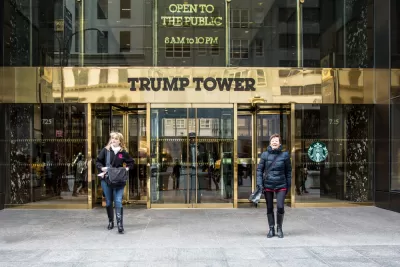Perhaps no development is more associated with the presumptive Republican presidential nominee than Trump Towers, which established his reputation as a developer with little regard for historic preservation and revealed his character in business.

With developer Donald Trump all but certain to be the Republican presidential candidate in November, Planetizen looks at his role as a developer, beginning in 1979, when he acquired the land to build his iconic Trump Towers.
The upscale Bonwit Teller women's department store on Manhattan's Fifth Ave. at 56th Streets opened in 1929. "American Architect magazine called it 'a sparkling jewel in keeping with the character of the store,'" wrote Christopher Gray in the New York Times Streetscapes column on Oct. 3, 2014.
At the very top of the facade were limestone relief panels of two nearly naked women brandishing large scarves, as if dancing. The architects were Whitney Warren and Charles Wetmore, super-traditional Beaux-Arts designers of mansions and clubs — a puzzling choice for a such an outré building. In time the reliefs would become a Bonwit Teller signature.
The relief panels are also referred to as Art Deco friezes or bas-relief sculptures. Gray goes on to describe the company and the store in more detail. "Bonwit Teller closed its store at Fifth and 56th in 1979."
That was good news for Donald Trump, who acquired the old Bonwit’s building and began demolition in 1980. He had promised the limestone reliefs of the dancing women to the Metropolitan Museum of Art, which wanted them for its sculpture collection, although the offer was conditional on his being able to remove them. But suddenly workmen jackhammered them to bits.
"It was a sin deemed unforgivable by landmark preservationists," wrote Marilyn Bender for The New York Times on August 7, 1983.
"Athough he later expressed 'regret' for the demolition, Trump took pains to point out that the negative coverage created free publicity and helped him sell apartments," wrote
“Bonwit Teller established him as a bad guy,” said Kent Barwick, then chairman of New York’s Landmarks Preservation Commission. “Afterwards, rightly or wrongly, there was a question of trust.”
A few years later, he stripped his name across Trump Tower on famously elegant Fifth Avenue, alongside Tiffany & Co., appalling those who viewed his glass high-rise as the equivalent of sticking a gold tooth in Queen Elizabeth’s smile.
One final Trump development to mention, one which he had to compromise in the mid 1980s. Former Planetizen contributor Roberta Brandes Gratz comments on what what have been Trump's tallest buildings.
"Whatever goodwill New Yorkers felt toward Trump was mixed with the fury he provoked with plans to build a wall of skyscrapers that would include the world’s tallest building — 150 stories — on Manhattan’s West Side waterfront," writes Schwartzman.
“I looked at this monster and I knew this was the death knell,” recalled Roberta Gratz, a leader of the opposition who writes about architecture.
Instead of 150 stories, he agreed to build nothing more than 48 floors and add a 21-acre park, setting the stage for a 13-block development that some in the neighborhood still refer to acidly as Trumpistan long after the developer sold his stake.
FULL STORY: Donald Trump's Legacy as a Developer

Alabama: Trump Terminates Settlements for Black Communities Harmed By Raw Sewage
Trump deemed the landmark civil rights agreement “illegal DEI and environmental justice policy.”

Planetizen Federal Action Tracker
A weekly monitor of how Trump’s orders and actions are impacting planners and planning in America.

The 120 Year Old Tiny Home Villages That Sheltered San Francisco’s Earthquake Refugees
More than a century ago, San Francisco mobilized to house thousands of residents displaced by the 1906 earthquake. Could their strategy offer a model for the present?

In Both Crashes and Crime, Public Transportation is Far Safer than Driving
Contrary to popular assumptions, public transportation has far lower crash and crime rates than automobile travel. For safer communities, improve and encourage transit travel.

Report: Zoning Reforms Should Complement Nashville’s Ambitious Transit Plan
Without reform, restrictive zoning codes will limit the impact of the city’s planned transit expansion and could exclude some of the residents who depend on transit the most.

Judge Orders Release of Frozen IRA, IIJA Funding
The decision is a victory for environmental groups who charged that freezing funds for critical infrastructure and disaster response programs caused “real and irreparable harm” to communities.
Urban Design for Planners 1: Software Tools
This six-course series explores essential urban design concepts using open source software and equips planners with the tools they need to participate fully in the urban design process.
Planning for Universal Design
Learn the tools for implementing Universal Design in planning regulations.
Clanton & Associates, Inc.
Jessamine County Fiscal Court
Institute for Housing and Urban Development Studies (IHS)
City of Grandview
Harvard GSD Executive Education
Toledo-Lucas County Plan Commissions
Salt Lake City
NYU Wagner Graduate School of Public Service


























